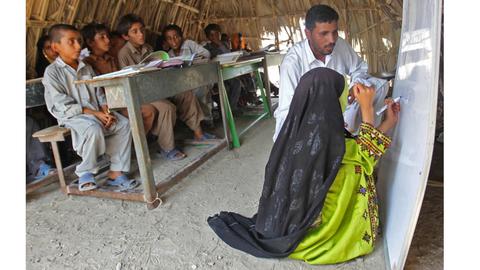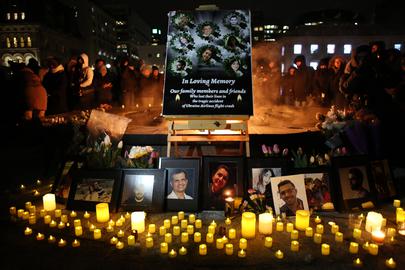“We have one thousand schools made out of clay in Iran, and 1700 units of temporary containers that serve as mobile schools. Insecure schools in the country [number] close to 83,000, and 30 percent of Iran’s schools are worn out. Today, there is a shortage of about 40 million square meters of educational space nationwide. In such an environment, the Iranian Minister of Education says Iran is ready to participate in the process of rebuilding Syrian schools.”
This is what one teacher trade unionist told IranWire when we spoke to him about Mohsen Haji Mirzaei, the Iranian Minister of Education’s recent visit to Syria, and the speculation that followed. “I met with my Syrian counterpart in Damascus today,” the minister wrote on Twitter. “He told me that during the many years of conflict in Syria, about 2,000 schools were destroyed. I told him we are ready to help with rebuilding Syrian schools with our country’s experience in rebuilding and equipping training units—which we had to deal with during the imposed war [with Iraq]. ”
But the teacher I spoke to challenged the minister’s confidence. “The claimed knowledge and experience that they want to give to others freely has not been used to build schools in Iran in areas that either do not have a school or have schools in ruin. During a visit to the flood-hit areas of Sistan and Baluchistan province, the minister announced that, except for four schools that needed major repairs, the rest of the province's schools had been destroyed by the flood. Knowing Iranian schools need to be rebuilt, how can they jump in to build schools in Syria? Does he even pay attention to his executives? The director-general of the Office of Public Partnerships for School Renovation, Development and Equipment has reported a shortage of at least ‘40 million square meters’ of educational and school space in the country.”
70% of Tehran Schools are Out of Date and Unsafe
While Haji Mirzaei was pledging to rebuild Syrian schools, Tehran’s mayor, Pirouz Hanachi, announced on January 28: “Of the 2,888 schools evaluated in the capital, 827 schools are in extreme danger” and unsafe. On the same day, Mohsen Hashemi, the head of the general counsel of the city of Tehran, said that out of 4000 schools in Tehran, between 60 and 70 percent are in bad shape, and added: “the government is in financial crisis and has, therefore, spent less in Tehran.” He also pointed to “the existence of 50 judiciary sentences against schools [because of] safety violations and [with regard to] construction of new units.”
In June 2019, Ali Shahri, the director of Tehran’s Department for School Renovation, Development, and Equipment, said there were 23,000 outdated classrooms in the province. “Tehran province is at the top of the list in terms of outdated educational facilities, and its need for reconstruction, demolition, and enhancement of schools is serious. Currently, about 23,000 classrooms throughout the province need to be demolished and rebuilt. In the 2019 census, it was reported that 16,000 of these out-of-date classrooms are in the capital.”
The purpose of Minister of Education Haj Mirzaie’s trip to Syria was not made public. “But one thing is clear,” said a post on Telegram by teachers’ union activist Shirzad Abdollahi. “The trip was not an initiative of the minister or President Rouhani’s cabinet — because policies in Iraq, Syria, Lebanon, and Yemen are entrusted to institutions beyond the government.” Abdollahi described the move as “a mission to normalize the consolidation of Bashar al-Assad’s Ba’athist regime and the transition from civil war and the beginning of a constructive period,” and added: “Mr. Haji Mirzaei signed a memorandum of understanding with his Syrian counterpart, in which, according to the Iranian side, cooperation on teacher training, specialist education, equipping schools, publishing textbooks, literacy and exchange of experiences in various fields was agreed.” Ultimately, the Supreme Leader determines the policies of the Islamic Republic, and specifically when it comes to Iran’s involvement in the wider region.
Iranian Schools at Risk Because of Unsafe Heating
Syria’s al-Watan newspaper reported that Iran had pledged 12 billion liras to boost schools in Syria. Speaking to IranWire, one teacher said that the education minister could protect Iranian schoolchildren by ordering oil heaters in schools to be dismantled, thereby reducing the risk of fires. “Given the minister’s 12-billion-dollar commitment to rebuild 250 schools in Syria, it is not a bad idea to look at classroom fires in Iran,” the teacher said. “The Syrian lira is currently priced at around 330 tomans today; this means that the minister’s commitment amounts to about 3.960 billion tomans from the state budget. Had these funds been spent on renovating, rebuilding, or even dismantling oil heaters, would we have seen the continuation of classroom fires?”
According to the trade unionist, “The fire caused by an oil heater at the Doroodzan School of Marvdasht in Fars in 2006 injured eight female students. The authorities hid the news of the disaster for 15 days until, eventually, the head of the state inspectorate announced it at a meeting with education officials. In the court rulings, the Ministry of Education was blamed. However, oil heaters are still used in classrooms in the provinces. Thirteen years after the fire at Doroodzan School, those girls, who are now 20 years old, are still struggling with the calamities of that incident.”
Fires in schools across the country have been widely covered in the media, but not every tragedy has been reported, despite pressure on education authorities to make these statistics public. Some of the most serious incidents are listed below:
— Thirteen students died in October 2004 in Sefilan village school in Lordegan, Chaharmahal Bakhtiari province
— A student died in October 2010 following a fire in a student boarding dorm in Sistan and Baluchistan
— Two students died, and three students were subjected to severe burns in October 2011 at a fire at Chabahar University Boarding School
— Forty-five female students suffered from burns in their classroom at Shinabad Village Girls’ Primary School on December 5, 2012
— An oil spill from a heater in a temporary classroom in the Bargahi village outside the city of Dashtestan caused a fire in a school on December 13, 2015. Disaster was averted thanks to the quick action of a teacher at the school
— Alireza Saghi, a teacher at Homamloo Village School in Meshkin Shahri, saved his students’ lives on December 12, 2016 after an oil heater caused a fire — the second such fire at the school
— On December 18, 2018, three students died from severe burns following a fire at Osaveh Hasanah Elementary School in Zahedan. A fourth student also suffered burns. The fire department reported that an oil heater was to blame for the fire. In the aftermath of the fire, the head of a non-governmental school organization visited Zahedan on December 20, 2018, and reported: “Oil lamps heat 7,000 classrooms in Zahedan”
— Mehrollah Rakhshani Mehr, Iran’s Deputy Minister of Education and Head of the Organization for the Renovation, Development, and School Equipment of the country on July 23, 2018, announced: “Thirty percent of schools in the state are worn out. Twelve percent of them are being considered for demolition, and 18 percent are subject to a support plan for rebuilding.” He went further declared, “Eleven provinces of the country are below the national average in terms of educational space.” He said Tehran, Khorasan Razavi, Gilan, and Sistan and Baluchistan provinces the most in need of renovation and reconstruction. According to Rakhshani, the country’s forthcoming development plan was also estimated to include 3 billion dollars for school reconstruction, but has not yet been allocated as a legal obligation.
Very Basic Conditions
In addition to fire risks, schools across Iran report an urgent need of infrastructure, supplies, equipment and building upgrades. For example, in the southern and eastern parts of Kerman province, one of Iran’s poorest areas, school officials report that classrooms are extremely basic, and that lessons often have to take place under minimal shelter, or even outside. Students are often forced to sit on the floor, with only the teacher having a chair to sit on. A teacher from one of these schools, in the village of Jafarabad near Roodbarjanob told Mehr News Agency that poverty was having a detrimental affect on educational services.
Iran’s Ministry of Education has repeatedly called on charities to help in the repair and upgrade of school buildings, leaving many to wonder why the government is not taking a more leading role.
Raskshani Mehr reported on January 2, 2020, that over the last 20 years, benefactors and non-governmental organisations had been responsible on average for about 30 percent of re-built or improved school facilities. “This figure has increased in recent years,” the charity said. “Charitable donations built about 50 percent of newly-built classrooms in the country in 2018, and 2019.”However, the spokesman could not comment on what share of the improvements the government had taken on.
Lies from Ministers
Two days after the tweet about helping Syrian schools, Adel Berkem, a teacher’s trade union activist, appealed to the minister on Twitter : “Please publish the full text of the agreement [with Syrian education officials].” Berkem also called on Iranian officials to explain why this aid was so widely covered by Syrian newspapers, and seemed to be less than common knowledge among the Iranian public.
But Ministry of Education official Ali Bagherzadeh denied the claims that Iran would be offering significant financial support to Syrian schools. “No promises were made to build schools, and there was no talk of building schools.”
Activist and unionist Shirzad Abdollahi says Iranian officials should go public with the details of its commitments. “If there is no financial commitment by the Iranian government, and Iranian contractors are supposed to only help to construct schools with the Syrian government’s financial support, why are there 250 schools listed [as being helped by Iran]? Where does the funding for these schools come from? Is the school renovation budget allocated to this, or is the government going to fund it with another deficit? The release of photos by the Minister of Education and the Iranian delegation under the symbol of the bloodthirsty Syrian dictator Bashar al-Assad is a sign of Mr. Haji Mirzaei's cruelty.”
visit the accountability section
In this section of Iran Wire, you can contact the officials and launch your campaign for various problems


























comments